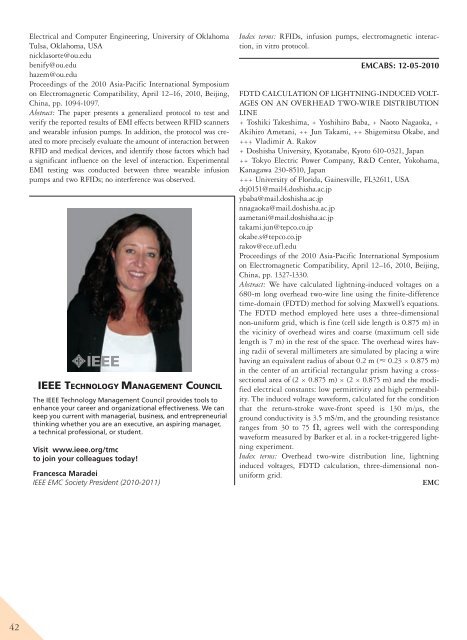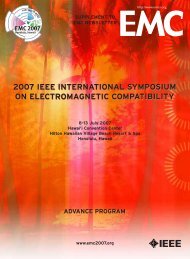Tutorial: EMC & Signal Integrity using SPICE, page 44 - IEEE EMC ...
Tutorial: EMC & Signal Integrity using SPICE, page 44 - IEEE EMC ...
Tutorial: EMC & Signal Integrity using SPICE, page 44 - IEEE EMC ...
Create successful ePaper yourself
Turn your PDF publications into a flip-book with our unique Google optimized e-Paper software.
42<br />
Electrical and Computer Engineering, University of Oklahoma<br />
Tulsa, Oklahoma, USA<br />
nicklasorte@ou.edu<br />
benify@ou.edu<br />
hazem@ou.edu<br />
Proceedings of the 2010 Asia-Pacific International Symposium<br />
on Electromagnetic Compatibility, April 12–16, 2010, Beijing,<br />
China, pp. 1094-1097.<br />
Abstract: The paper presents a generalized protocol to test and<br />
verify the reported results of EMI effects between RFID scanners<br />
and wearable infusion pumps. In addition, the protocol was created<br />
to more precisely evaluate the amount of interaction between<br />
RFID and medical devices, and identify those factors which had<br />
a significant influence on the level of interaction. Experimental<br />
EMI testing was conducted between three wearable infusion<br />
pumps and two RFIDs; no interference was observed.<br />
<strong>IEEE</strong> TECHNOLOGY MANAGEMENT COUNCIL<br />
The <strong>IEEE</strong> Technology Management Council provides tools to<br />
enhance your career and organizational effectiveness. We can<br />
keep you current with managerial, business, and entrepreneurial<br />
thinking whether you are an executive, an aspiring manager,<br />
a technical professional, or student.<br />
Visit www.ieee.org/tmc<br />
to join your colleagues today!<br />
Francesca Maradei<br />
<strong>IEEE</strong> <strong>EMC</strong> Society President (2010-2011)<br />
Index terms: RFIDs, infusion pumps, electromagnetic interaction,<br />
in vitro protocol.<br />
<strong>EMC</strong>ABS: 12-05-2010<br />
FDTD CALCULATION OF LIGHTNING-INDUCED VOLT-<br />
AGES ON AN OVERHEAD TWO-WIRE DISTRIBUTION<br />
LINE<br />
+ Toshiki Takeshima, + Yoshihiro Baba, + Naoto Nagaoka, +<br />
Akihiro Ametani, ++ Jun Takami, ++ Shigemitsu Okabe, and<br />
+++ Vladimir A. Rakov<br />
+ Doshisha University, Kyotanabe, Kyoto 610-0321, Japan<br />
++ Tokyo Electric Power Company, R&D Center, Yokohama,<br />
Kanagawa 230-8510, Japan<br />
+++ University of Florida, Gainesville, FL32611, USA<br />
dtj0151@mail4.doshisha.ac.jp<br />
ybaba@mail.doshisha.ac.jp<br />
nnagaoka@mail.doshisha.ac.jp<br />
aametani@mail.doshisha.ac.jp<br />
takami.jun@tepco.co.jp<br />
okabe.s@tepco.co.jp<br />
rakov@ece.ufl.edu<br />
Proceedings of the 2010 Asia-Pacific International Symposium<br />
on Electromagnetic Compatibility, April 12–16, 2010, Beijing,<br />
China, pp. 1327-1330.<br />
Abstract: We have calculated lightning-induced voltages on a<br />
680-m long overhead two-wire line <strong>using</strong> the finite-difference<br />
time-domain (FDTD) method for solving Maxwell’s equations.<br />
The FDTD method employed here uses a three-dimensional<br />
non-uniform grid, which is fine (cell side length is 0.875 m) in<br />
the vicinity of overhead wires and coarse (maximum cell side<br />
length is 7 m) in the rest of the space. The overhead wires having<br />
radii of several millimeters are simulated by placing a wire<br />
having an equivalent radius of about 0.2 m (< 0.23 × 0.875 m)<br />
in the center of an artificial rectangular prism having a crosssectional<br />
area of (2 × 0.875 m) × (2 × 0.875 m) and the modified<br />
electrical constants: low permittivity and high permeability.<br />
The induced voltage waveform, calculated for the condition<br />
that the return-stroke wave-front speed is 130 m/μs, the<br />
ground conductivity is 3.5 mS/m, and the grounding resistance<br />
ranges from 30 to 75 V, agrees well with the corresponding<br />
waveform measured by Barker et al. in a rocket-triggered lightning<br />
experiment.<br />
Index terms: Overhead two-wire distribution line, lightning<br />
induced voltages, FDTD calculation, three-dimensional nonuniform<br />
grid.<br />
<strong>EMC</strong>

















